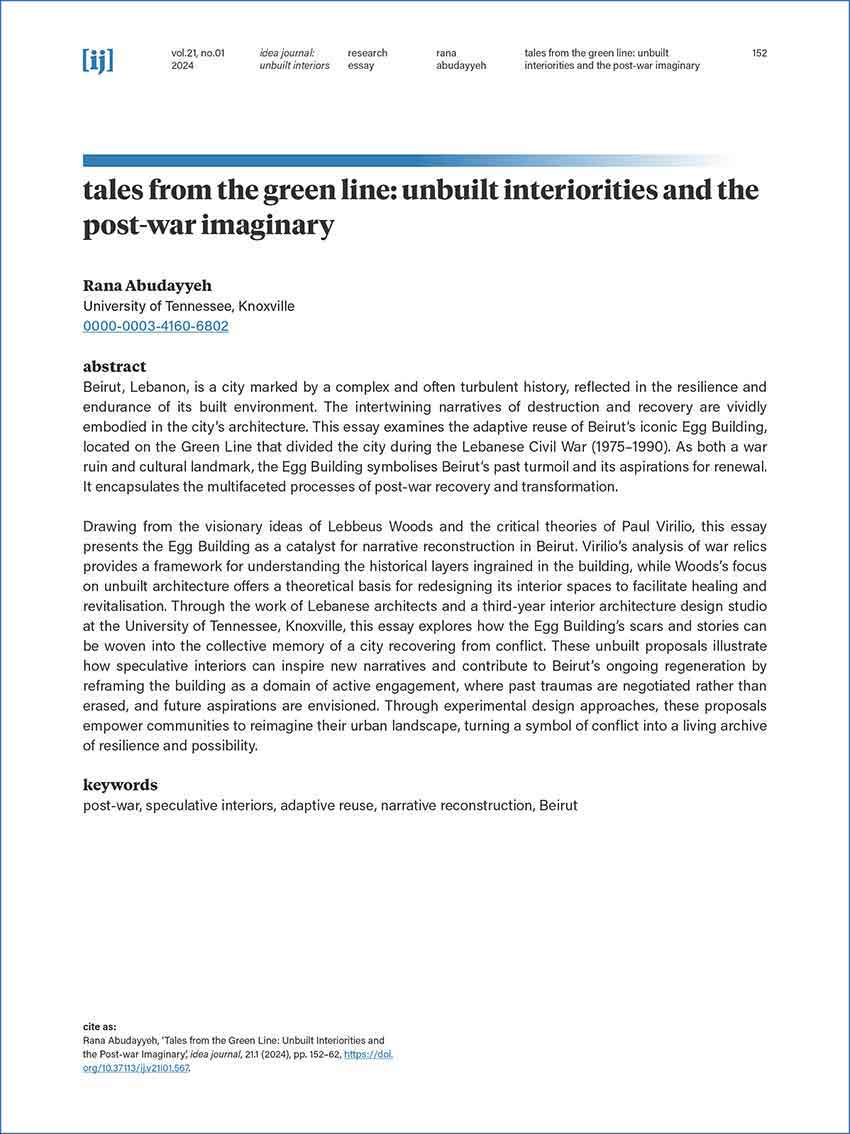Tales from the Green Line Unbuilt Interiorities and the Post-war Imaginary
Main Article Content
Abstract
Beirut, Lebanon, is a city marked by a complex and often turbulent history, reflected in the resilience and endurance of its built environment. The intertwining narratives of destruction and recovery are vividly embodied in the city’s architecture. This essay examines the adaptive reuse of Beirut’s iconic Egg Building, located on the Green Line that divided the city during the Lebanese Civil War (1975–1990). As both a war ruin and cultural landmark, the Egg Building symbolises Beirut’s past turmoil and its aspirations for renewal. It encapsulates the multifaceted processes of post-war recovery and transformation.
Drawing from the visionary ideas of Lebbeus Woods and the critical theories of Paul Virilio, this essay presents the Egg Building as a catalyst for narrative reconstruction in Beirut. Virilio’s analysis of war relics provides a framework for understanding the historical layers ingrained in the building, while Woods’s focus on unbuilt architecture offers a theoretical basis for redesigning its interior spaces to facilitate healing and revitalisation. Through the work of Lebanese architects and a third-year interior architecture design studio at the University of Tennessee, Knoxville, this essay explores how the Egg Building’s scars and stories can be woven into the collective memory of a city recovering from conflict. These unbuilt proposals illustrate how speculative interiors can inspire new narratives and contribute to Beirut’s ongoing regeneration by reframing the building as a domain of active engagement, where past traumas are negotiated rather than erased, and future aspirations are envisioned. Through experimental design approaches, these proposals empower communities to reimagine their urban landscape, turning a symbol of conflict into a living archive of resilience and possibility.
Article Details
Author/s and or their institutions retain copyright ownership over works submitted to Idea Journal, and provide the Interior Design / Interior Architecture Educators Association with a non–exclusive license to use the work for the purposes listed below:
- Make available/publish electronically on the Idea Journal website
- Publish as part of Idea Journal's online open access publications
- Store in electronic databases, on websites and CDs/DVDs, which comprise of post-publication articles to be used for publishing by the Interior Design / Interior Architecture Educators Association.
Reproduction is prohibited without written permission of the publisher, the author/s or their nominated university. The work submitted for review should not have been published or be in the process of being reviewed by another publisher. Authors should ensure that any images used in their essays have copyright clearance.

